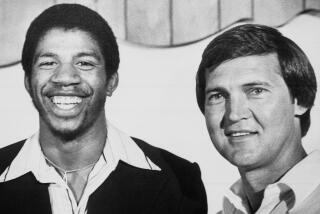Presto! Patients Get Moving With Magician
- Share via
Ed Forsythe usually puts his hands out flat on the card table when students in his magic class object that they cannot perform the tricks he is trying to teach them.
Only then do the students--most of them with serious head or brain injuries requiring extensive rehabilitation--see for the first time that Forsythe himself is disabled. He has severe arthritis in both hands, requiring therapy a year ago.
“I put my hands down and say, ‘Yes, you can do it!’ ” Forsythe says. “The patients don’t say anything, but they understand. I think it’s an advantage for me.”
Forsythe reaches into his bag of tricks once each week at both Sharp Memorial and the Veterans Administration hospitals in San Diego to help hone hand and verbal skills of severely disabled patients. It’s all part of a nationwide program, “Project Magic,” conceived several years ago by magician David Copperfield in Long Beach to help the disabled. The 67-year-old Forsythe is the only San Diego magician active in the program.
“Copperfield received a letter from a young man in a wheelchair who wanted to be a magician, and was so touched that he started up the effort,” Forsythe said. “I heard about it through (magicians’ association) journals and wanted to help out.”
At the time, Forsythe was teaching high school government classes in suburban Virginia outside Washington, after careers in Army intelligence and private defense contracting. He trained several therapists in the Fairfax school district in elementary magic. Magic routines are now a regular part of that system’s curriculum for disabled students.
After he retired in 1983, Forsythe and his wife moved to San Diego. His first contacts were made during rheumatology therapy at Scripps Clinic in La Jolla.
“My therapist put me in contact with the people at Sharp after learning about my magic background,” Forsythe said.
Forsythe has been running continuous sessions since, with as many as 15 to 20 students at a time whose difficulties range from leg amputations to severe injuries from auto accidents. He works with multiple sclerosis patients at the VA hospital.
“It’s much, much harder with those persons who have spinal or brain injuries,” Forsythe said. “The key in all cases is to get patient involvement: to get them to use their hands, to get multiple movement, to get them talking along with me as I do my patter.”
So there is the animated Forsythe during a class, smiling through a full set of teeth as his eyes dart behind black horn-rimmed glasses. He picks up a rubber band, wraps it around the tips of his index and middle fingers and then--presto with a dash of misdirection--transfers the band to his ring and little fingers. As his students stare in awe at the abracadabra, Forsythe quickly shows them the way the trick is done, forcing the class to pick up rubber bands--as painfully difficult as such a simple move is for many of them--and follow along.
“C’mon, Ozzie,” Forsythe implores Dee Osborne, a wheelchair-bound patient, as she wrestles with the rubber band.
When Osborne and the other students appear to become bogged down in rubber bands, Forsythe deftly moves the routine to card tricks, having Larry Huntington choose a card from the deck. Huntington struggles to pick his chosen card from the deck and receives a great smile from Forsythe when he successfully selects one. Forsythe’s correct “guess” of Huntington’s card is almost anticlimactic to the student’s handling of it.
“We’ve got a manual that lists 15 to 20 tricks for us to do that have therapeutic benefits, that have the patients make multiple movements and verbalize at the same time,” Forsythe said. “Of course, you’ve always got to be able to improvise and have another trick ready if the students can’t do those in the manual.”
Such improvisation is no problem for Forsythe, who discovered magic as a 10-year-old in Schenectady, N.Y., watching magicians at Saturday afternoon dime shows. At age 15, he was performing magic tricks at birthday parties for friends.
“I’ve always been a ham of sorts,” Forsythe said. “I’ve always liked to deal with people.”
Forsythe went to work as a part-time messenger at the massive General Electric Co. plant in Schenectady in 1935. After presenting his magic show at an employee Christmas party, Forsythe was promoted to a full-time department clerk. “I have no doubt it was because of the visibility from doing the magic,” he said.
Forsythe’s favorite tricks are among those he learned early in his career.
“I especially remember my first card trick, the so-called four-aces, where you put the four cards down on a table but they all end up in the same place,” Forsythe said. “I prefer small illusions, or so-called close-up magic, because that better displays the manipulation that is so much a part of magic.
“Most of the tricks I learned as a kid are so old that they seem new to young people today.”
Despite his arthritis, Forsythe can still perform most of his specialties. He said he does not mind revealing techniques of certain routines to his students.
After all, he said, the real magic is in watching his students succeed with the tricks.
More to Read
Sign up for Essential California
The most important California stories and recommendations in your inbox every morning.
You may occasionally receive promotional content from the Los Angeles Times.













